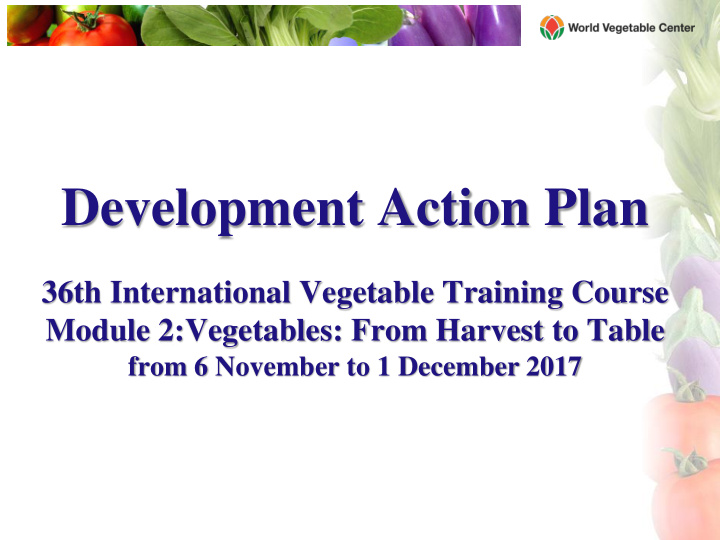



Development Action Plan 36th International Vegetable Training Course Module 2:Vegetables: From Harvest to Table from 6 November to 1 December 2017
Personal information Name: Mariam Al JAMMAL Nationality: Lebanese Education: Agricultural engineer Specialization: Agro-Economy and Sustainable Development + Master 2: Territorial Development and Projects DTP Work: - Basic: Lebanese Agriculture Research Institute LARI - Current: Ministry of Agriculture
Mains work responsibilities: - Inspecting: • In small agricultural properties and nurseries. • In agricultural pharmacies. - Member of committee for receiving, evaluating and check up of quality of wheat crop.
Lebanon • Capital: Beirut • Country area: 10,452 km² • Land area: 10230 km² • Agricultural area: 6,580 km² • Population: 6,086,905 => 0.08% of • Forest: 1,372.2 km² the total word population. • Percent of rural population: 12% • GDP: $53.92 billion USD (2017) • Agriculture GDP: 7% • Climate: Mediterranean
Cultivated crop Fruit Governorate Cereals Olives Vegetables Trees Mount 3,140 97,820 77,678 31,100 Lebanon North 120,380 135,685 209,628 128,584 Beqaa 297,737 217,570 31,443 259,743 South 37,638 123,304 89,340 20,753 Nabatiyeh 59,525 20,768 116,124 12,141 Total 518,420 595,147 524,213 452,321 North and Beqaa is the most cultivated area
Most 3 useful TOPICS: ✓ Chemical residue analysis in vegetables ✓ Quality and standards controls ✓ Market assessment and market information system
Minimizing pesticide residues in fruits and vegetables to safeguard human health
Principal problems in Fruits and vegetables in Lebanon • Pesticides persist on local produce. • Farmers spraying too often pesticides. • No effective monitoring programs to ensure the safety of local produce on the market. • Products “BIO” are so expensive. • Farmers harvesting produce too quickly after spraying pesticides. • Monitoring of produce for exportation not for local market. • Lack of education and training for farmers.
Relation between pesticides residue and human diseases Cancer Pesticides residue in food products Birth Neurological effect defect (children)
Washing ≠ Safe Contact Washing F & V can eliminate pesticides But Systemic PERSIST Pesticides
Problematic : Are our vegetables safe from pesticides residue?
Objectives : • Reduce pesticides residuals persisting after harvest • Aware farmers about the suitable time of harvest after spraying pesticides in order to reduce the high level of chemicals residue. • Increase the income and profit of farmers. • Ensure healthy F & V for consumers.
Who is beneficiaries? ➢ Farmers ➢ Consumers
Method Activity Input Time Location -F&V sample Jan 2018 - Local market, Sampling cultivated lands, - Personnel Jan 2020 supermarkets, small shops, cooling storage -Lab staff Jan 2018 - Experimentation : Testing the quantity - Lab Jan 2020 _ of residues of pesticide equipment - Materials/kits Research: -Researcher Feb 2018 - - Extension May 2018 1- On quantity and quality of pesticides tolerance that not affect human health agents _ 2- Comparing results with international standards (Norm) Inspection and check up: -Personnel Jan 2018 - Agricultural pharmacy, Jan 2020 Creation and distribution of label design warehouse of pesticides and cultivated lands
Estimated budget Number 2018-2020 Researcher 3 320 000 $ Personnel (contract) 10 130 000$ Lab technicians 15 270 000$ Lab equipment 4 200 000$ Transportation _ 10 000$ Lab materials/ kits _ 25 000$ Maintenance _ 30 000$ Total 985 000$
Outputs • Elaborations of certified norm • Elaboration of guideline: • How to use pesticides Stimulation by For Farmers: (quantity). marketing of labelled • Harvest-time: how long one Training session products must wait between spraying produce and harvesting it. (price differentiation) • How and what to eat properly (washing, peeling). For Consumers: Manuals and brochures • Importance of buying certified and labelled Awareness campaigns varieties.
Outcomes • Increasing awareness of farmers and consumers. • Improve nutrition status by changing dietary habits. • Increase the income of farmers by supporting the marketing of labelled produce. • Transfer knowledge. • Safe products for exportation.
Assumptions • Standard taken seriously by farmers • Farmers and consumers interested to participate in training • Availability of Lab equipments
Thank Thank You You AARDO IVTC Staff World Vegetable Center Lecturers Thai people Colleagues …
Recommend
More recommend